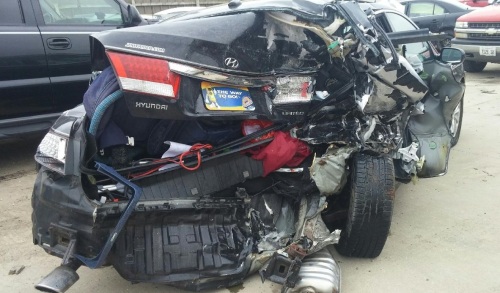Hey folks,
It’s been a while since I felt the need to blog about something on here. A big Illinois Supreme Court case came down recently that may have changed how auto accident photos are used at trial. Let’s talk about it.
Older cases like DiCosola v. Bowman and Baraniak v. Kirby essentially held that, without expert testimony, car crash photos do not come into evidence in car accident cases to prove either the severity of the plaintiff’s injury or lack thereof. Later cases seemed to walk that back a little, but in practice, car damage photos rarely came into evidence.
That’s about to change. In Peach v. McGovern, 2019 IL 123156 (2019), the Illinois Supreme Court essentially overruled DiCosola and Baraniak. The key quote: “If a jury is allowed to consider relevant testimony about vehicle speed and impact forces, a jury should be permitted to consider photographs that depict the damage, or lack thereof, done to vehicles.” The other key quote is: “Juries are entitled to infer that which resides squarely in the center of everyday knowledge, the certainty of proportion, and the resulting recognition that slight force most often results in slight injury and great force most often is accompanied by great injury.” But is that true?

My client was in the car above. She had no major injuries at all. Walked away. Honestly, I have probably felt as sore a day after a hard workout.
Are laypeople really capable of correlating vehicle damage with occupant injury? Here are some of the difficulties:
- Do the photographs show the actual damage? Often all you get is a blurry shot or two of a bumper. Is there frame damage? Is there damage to an axle or more? If so, what type of impact does it take to damage those things?
- What condition was the plaintiff in before the crash? It should be common knowledge that some people are more prone to serious injury than others. A 20 year old athlete, for example, would most likely bounce back from a whiplash injury easier than a 70 year old with degenerative disc disease and a narrow spinal canal.
- How much force was required to cause the damage shown?
- How much force was required to injure (a) someone, (b) everyone, or (c) no one?
The issue is that someone on the jury will certainly have been in a car wreck that totaled their car – yet they weren’t hurt much. By that logic, many jurors will assume that any wreck where a car was NOT totaled could not possibly have caused an injury. This simply is not true.
Remember that the case is not about the damage to the car, but the damage to the person. The case is about the transfer of force. Neck injury cases are about how the defendant’s car hit the plaintiff’s car, causing force to be transferred into the plaintiff’s body (think of a croquet mallet/ball) and causing her neck to snap back in a way that her body was not prepared for.
Of course, this case cuts both ways. In the case above, I could have shown the jury this photograph – and others – heck, I would have made them Exhibit #1. But the logic would have been faulty, in the same way as showing a minor bumper scratch to argue that a person wasn’t hurt.
For practitioners, there are good arguments you can make using the Peach case. When the defense counsel argues that the case holds that photos always automatically come in, remind the judge that the case doesn’t say that – it says “the essential question
in deciding the admissibility of postaccident photographs is whether the jury
understands the evidence and can relate the vehicular damage depicted in the
pictures to the injury without the aid of an expert. This is an evidentiary question to
be resolved by the trial judge. ” Use your best MIST arguments (or at least your second best MIST arguments – save the absolute best for the jury) with the judge to help her understand that your case is not an appropriate one to show photos.
Also, be aware that Peach specifically drew a distinction between cases where a prior injury was involved. As good Illinois car accident attorneys know, the Voykin case held that a defendant must put on expert testimony to connect a prior injury to a current injury. The DiCosola and Baraniak cases drew on Voykin for their reasoning. In Peach, the court drew a distinction there, noting “Here, as in Baraniak and DiCosola, there is no prior injury involved. This is not a case where jurors must determine whether there is a connection between the plaintiff’s past and current injuries. Given that factual distinction, there is no common thread connecting the reasoning in Voykin to this case.” Where there are past injuries, I think there’s a good reason to exclude photographs based on that logic.
The bottom line is that minor impact cases just became a little tougher for plaintiff’s attorneys. There are still good arguments to be made to exclude vehicle photographs, and good arguments for the jury as to why they aren’t conclusive – but I don’t want to give away all of my secrets today.
(Howard Zimmerle is a personal injury lawyer in Rock Island Illinois. He can be reached at hzimmerle [at] qclawyers.com or 309-794-1660).